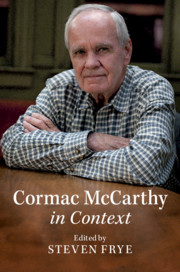Book contents
- Cormac McCarthy in Context
- Cormac McCarthy in Context
- Copyright page
- Contents
- Contributors
- Acknowledgments
- Chronology
- Part I Environments
- Part II Literary Contexts: Sources, Influences, Allusions
- Part III Intellectual Contexts
- Chapter 12 The Judeo-Christian Tradition
- Chapter 13 Gnosticism
- Chapter 14 Classical and Pre-Classical Philosophy
- Chapter 15 Nineteenth- and Twentieth-Century Philosophy
- Chapter 16 Formal Aesthetic Choices
- Chapter 17 Science and Technology
- Part IV Social and Cultural Contexts
- Part V Archives, Critical History, Translation
- Works Cited
- Index
Chapter 12 - The Judeo-Christian Tradition
from Part III - Intellectual Contexts
Published online by Cambridge University Press: 12 December 2019
- Cormac McCarthy in Context
- Cormac McCarthy in Context
- Copyright page
- Contents
- Contributors
- Acknowledgments
- Chronology
- Part I Environments
- Part II Literary Contexts: Sources, Influences, Allusions
- Part III Intellectual Contexts
- Chapter 12 The Judeo-Christian Tradition
- Chapter 13 Gnosticism
- Chapter 14 Classical and Pre-Classical Philosophy
- Chapter 15 Nineteenth- and Twentieth-Century Philosophy
- Chapter 16 Formal Aesthetic Choices
- Chapter 17 Science and Technology
- Part IV Social and Cultural Contexts
- Part V Archives, Critical History, Translation
- Works Cited
- Index
Summary
Nothing is more characteristic of Cormac McCarthy’s literary style than what Richard Woodward has called the “biblical gravity” of his prose. While references to the Bible abound in McCarthy’s work, it is the archaic vocabulary, powerful cadence, formal and thematic repetitions, and above all the paratactic syntax of McCarthy’s style inspired by the King James Bible that provide the closest link between his fiction and the Judeo-Christian tradition. This chapter examines the convergence of religion and aesthetics in McCarthy’s work as well as the function of a biblical narrative style in the fully administered world of contemporary society. Through readings of McCarthy’s essay “The Kekulé Problem” (2017), the importance of Christian mysticism to his work, and his peculiar association with the Santa Fe Institute, the chapter shows how McCarthy’s fiction draws on the Judeo-Christian tradition in order to produce a sense of mystery in the disenchanted world of modernity. At the same time, this production of mystery entails a mystification of literature that the chapter places in the postwar literary context in which McCarthy began his writing career.
Keywords
- Type
- Chapter
- Information
- Cormac McCarthy in Context , pp. 121 - 131Publisher: Cambridge University PressPrint publication year: 2020

